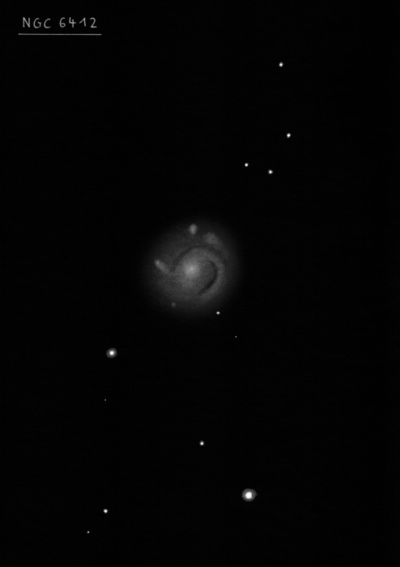
William Herschel discovered NGC 6412 = H VI-41 on 12 Dec 1797 (sweep 1071) and surprisingly described this galaxy as a cluster of class VI (very condensed and rich clusters of stars) -- "round, resolvable, about 3' diameter, vgbM. I suppose it to be a cluster of stars compressed extremely. 320 power confirms the supposition, and shews a few of the stars; it must be immensely rich." CH's reduced position is 30 tsec west (only 1.8' at this dec) of Arp 38 = UGC 10897. Bigourdan measured an accurate position on 24 Jul 1884.
200/250mm - 8" (8/5/83): very faint, small, diffuse. Located north of two mag 8 stars in field.
400/500mm - 17.5" (7/9/88): moderately bright, irregularly round, 2.0' diameter, diffuse halo, weak even concentration to a brighter core. A mag 13.5 star is at the SW edge 1.1' from center. A string of three equally spaced stars begins with a mag 11 star 2' SE and includes two bright stars; mag 8.3 SAO 8824 4.1' S and mag 9.3 SAO 8821 7.6' SSW.
900/1200mm - 48" (10/22/11): at 375x appeared bright, large, round, 2' diameter. Broad concentration with a large, brighter 30" core, hint of spiral structure in the halo though it was difficult to trace the arms. An HII knot or companion was easily seen superimposed at the edge of the halo on the north side (37" from center) and appeared faint, small, oval, ~12"x8". A mag 13.5 star lies 1' SW and a mag 16 star is 1.8' SW; both stars are collinear with the core. A bright mag 11.3 star lies 2' SE. Listed by Arp as a spiral with a "low surface brightness companion on arms", but the "companion" may be an HII region.
Notes by Steve Gottlieb